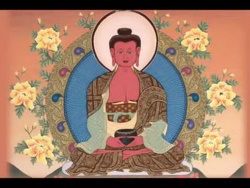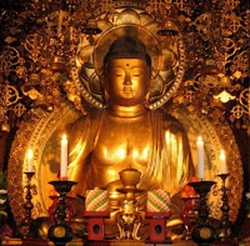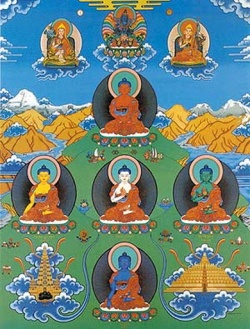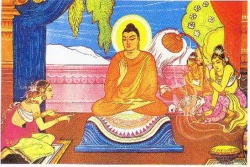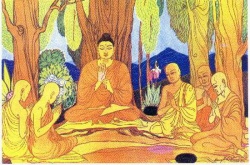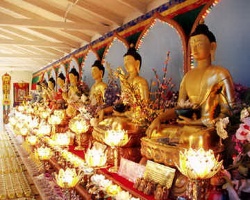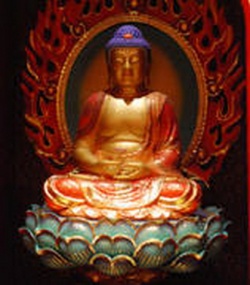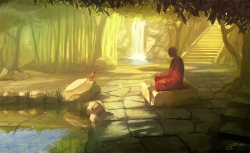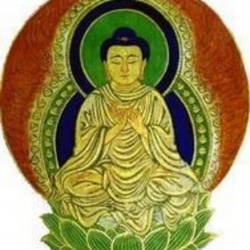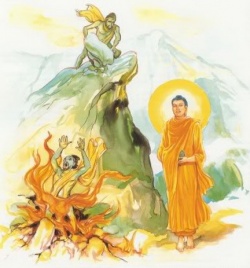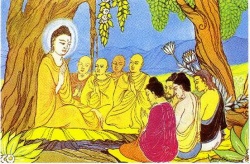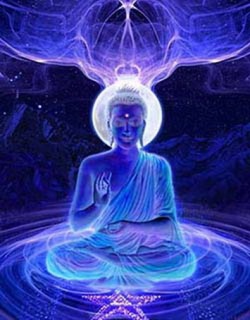The Practice of the Pure-Land School Simplified
I. The Necessity
A. No treatment by nature is so equal towards everybody as death. The poor must die and the rich also; foolish people must die and wise ones too; the weak and powerful also; sinful individuals and virtuous people must die; the common people must die, as well as emperors and kings. Neither in the sky nor in the ocean nor in a cave nor underground can a living being escape death. Communists may think of themselves as bacillus which can infect everybody throughout the whole world, but where is Stalin today? Fascists may think of themselves as gods who are able to control every country on earth, but where is Hitler now? In this Saha world there is no one who is free from death. But in the Sukhavati world, there is no death. Good rebirth in such a world is the aim of the practice of the Pure-Land School.
B. Although the practices of various schools are cast in different molds, all the practices of the different schools leave their practitioners still subject to death.
Chih-I the founder of the T'ien-T'ai School and Han-Shan, a Patriarch of the Ch'an School, both repeated the name of Amitabha at the time of their death. In the Tantric School, there is a method of Phowa. In the Ch'an School there is a Hua-Tou "Who repeats the name Amitabha?" Hence one should not take the conception of a school too literally.
To confess one's evil deeds and perform good karma, one has to tread the pathway of the Vinaya school; to learn the right Dharma and all of Buddhist psychology, the path of the Idealistic school; to control one's mind and unfold the potentialities of Tathata, the path of the T'ien-T'ai School is to be followed; to study the Voidness of Truth and perform all good deeds to benefit others, there is the path of the Prajnaparamita school; to gain some mystic power from the Samapatti of the real-value of conditional-nature, there is the path of the Hua-yen school; to develop wisdom energy and a wisdom body follow the path of the Tantric school; to directly discover the final truth and attain the perfect realization there is a path of Ch'an, and to control and transcend one's consciousness to get good rebirth, there is the path of the Pure-Land School. One who is a perfect Buddhist should learn the practices of all the doctrines of all schools. Why should the important practice for one's good rebirth be disregarded?
C. Under the influence of Mercantilism and sightless pragmatism, Westerners scarcely get any real Ch'an works to study except a few translations from ancient Chinese Ch'an works. In this Kali age there is no shame about what one writes for money and false reputation. Neither is there honesty, truth, reason or devotion for what one writes; these modern authors have to be led by the nose by the advisor of the publisher who wants one work to satisfy all readers of every religion, so that the profound truth of Ch'an must be omitted. Writers make contact with Buddhist societies as if they are real Ch'an scholars and give lectures there for the purpose of proving that their publications are worth buying and reading. Japanese monks are introduced to give lectures to prove that sitting straight and counting the breath accurately are the real Ch'an practices. Thus advisors, publishers, and society form an Indra-net of false Ch'an teaching. People subjected to such instruction are never awake to what they are doing; they are actually tied to the apron-strings of mercantilism but still think they are propagating real Ch'an teaching.
Most Western readers are apostates of [[Wikipedia:Christianity|Christianity]]. In their inward thoughts they think it is bad not to have any religion, but that it is better to follow one that has no god, no soul, and no doctrine of renunciation. Hence they choose Ch'an Buddhism (or Zen as it is known in Japan) as their religion. They mistake Ch'an Buddhism as a religion which fits in with their ideals. Eastern Ch'an Buddhists who seek after pleasure, the dollar, and who love the West emphasize that Ch'an Buddhism does not admit the existence of a god, a soul or a doctrine of renunciation but that Ch'an is found in daily life and needs no practice of any kind for the Ch'an is continually appearing. Such a misconception very much encourages those westerners, and certainly such eastern scholars are misleaders who have joined with western publication advisors to form a net of Charlatans. Most readers are not able to be free of this kind of net.
Buddha rejects the doctrine of an absolute god and permanent soul, but he never said that there is no conditional god and impermanent soul. He allows that one who has become accomplished in the voidness Samadhi may connect with evil persons in this world in order to convert them to the Buddhist order; but he never allowed his new disciples to share and indulge in the sorrows of evil ones in this Saha world. He who does not know how to get the entrance of Ch'an and how to be free from the volition of Ch'an cannot practice the Ch'an of daily life. I dare to say that most western believers of the Ch'an school have been deceived by those advisors and false Ch'an masters.
Regarding the practice of Tantra, many Western hypocrites outwardly refuse the doctrine of Vajra-love but inwardly they want to try to practice it. Young brothers and sisters after they have read the Hevajra-Tantra have much interest in it and immediately try to practice it without proper initiation. This is very dangerous and they will only fall into Hell instead of attaining rebirth in Sukhavati.
Hence among all the practical schools, the only one which is reliable and one may easily follow is the Pure-Land School.
II. The Rectification
Traditionally the doctrines of this school are in extremely different emphasis, some of which are quite right while others are in need of rectification. It is the natural law of mankind that to follow the right doctrine is as difficult as climbing a hill, but to follow the false doctrine is as easy as slipping down a slope. It is also true that the right doctrine grows slowly and is easily forgotten, while the false one grows fast and creates wide influence. Hence we who introduce this doctrine of this school to the West have to rectify the false doctrines lest practitioners accidentally wander between these two different ways.
This occurs since some Chinese ancients of this school emphasized that by only repeating an incantation of Amitabha ten times one may get rebirth in Sukhavati. Their opinion was based upon the Amita Buddha Sutra in which it was written: "Should such an unwise person, at the moment of his passing away, meet a Benefactor who teaches him how to repeat the name Amita Buddha and he would sincerely say in his heart, 'Namo Amita Buddha' ten times without interlude, he would be reborn in Sukhavati immediately." But the ancient commentators ignored the different attitudes found at the time of death and at other times. When one is going to die, one may be earnest and enthusiastic to repeat this and there would be no desire wedded in his mind and no chance to further sin. That is why although the repetition is only done ten times, yet their degree of inspiration is very strong and deep and much better than those repetitions which are done by living persons in an unintentional way. The person who is just converted at the time of his death is like a new student whose devotion is much deeper than that of longtime ones. The following poem translated from Chinese may serve as proof:
- Believing in Buddha the first year,
- Buddha seemed very near;
- But in the second year on one day,
- Buddha has gone away!
Certainly it is not that the Buddha has gone away, but that the practitioner's devotion has become insipid by being mixed with worldly desires.
This mistake can greatly harm the practitioner by increasing his laziness, and the result is that he just whiles away his time. Rome was not built in a day, so how can Sukhavati be gotten to by such an easy way? In this Kali age this traditional mistake added to indolence of human nature has widely influenced practitioners. Recently I received a letter from a German Buddhist who was studying in Japan asking me whether it is true that by repeating something a few times one may get rebirth in Sukhavati despite whatever great sins he had committed. Here the repetitions done at the time of death were mistaken as that done in usual times. Certainly this is a saying of the Japanese blind being lead by the Chinese blind.
Being a Chinese Buddhist as I am, this traditional error should be pointed out through reason and example. Did not the patriarch of this school in Japan, Rev. Sen Toa, practice very diligently? He created a ritual named "Confession in Six Times" which should be performed three times throughout the whole day and three times throughout the whole night. For this reason the Japanese Pure-Land School is also called the "School of Time." To this patriarch, even a little moment was not to be wasted without repetition. Besides repetitions, by worship, praise, confession, writing the Amita Sutra and performing many good conducts, he set down his personal example for us to follow. He himself copied this sutra one hundred thousand times. He drew three hundred different forms of pictures of Sukhavati. He repeated the Holy name numberless times. After he received realization, the holy light shone from his mouth and he still continued his repetition until passing away.
Surely the Pure-Land is not a Land of Nod; the Sine quo non (indispensable) for good rebirth is diligence but not dolce far niente (indulgent laziness). Those sleeping partners and waiters on Providence will never share the happiness of Sukhavati. Lazy people who take the least pains will never flee from transmigration.
- B. Mistaking the Sins Committed before One's Conversion which May Be Confessed and Excused, as Those Committed Frequently after One's Conversion
It is written in the Visualizing Amita Buddha Sutra that even a sinner who commits the five enormities and thus will fall into hell, may have all his sins excused and get rebirth in Sukhavati if he is converted by some benefactor at the time of his death and repeats the Holy name. But some Chinese ancients who had the good intention to convert those sinners said that their great sins may be continued when they get rebirth in that Pure-Land. Thus those sinners who repeat the Holy name on one hand and commit great sins again and again on the other hand, just treat Sukhavati as if it is the refuge for their evil. That is why many members of this school in China often kill chickens, fish, doves and other kinds of animals for their meals. This kind of sinner may be found in China ever and anon. I am very unhappy that even many of my patrons who were advised by me have not forbidden themselves such sins. It is my hope that those in the West may have a good start. Hence I set forth this rectification here. If one does not become a vegetarian, at least he should forbid himself to kill. After one's conversion, every sin one has committed may be an obstacle to his rebirth. One who causes others to die and seeks a good rebirth only for himself will never succeed. Unlike a person who is converted at the time of his death and has no chance to further commit any sins, one who is living may get many opportunities to do evil. Just like the proverb which runs: "He who fights and runs away may live to fight another day; but who's in the battle slain will never fight again." One should be afraid of committing a sin. In the midst of life or in death one should enthusiastically repeat the Holy name.
- C. Mistaking the Signs of Heavenly-rebirth as Those of Sukhavati-rebirth
The Ancients have set down many records and rebirth biographies wherein are collected all the signs which happened at the death of many monks and laymen but in these works the signs of heavenly rebirth are mixed with those of Sukhavati. Without proper examination and discernment between this difference, some of the ancients arbitrarily and discretionally exaggerated, saying, "Myriad people have repeated, myriad people have gone." Hence I have to point out the discriminations between these two kinds of signs and rectify the Ancient's saying with "Myriad people have gone to heaven but few people to Sukhavati."
In general, good rebirth either in heaven or in Sukhavati is indicated by the same signs as follows:
- Heavenly music,
- Holy light,
- Lotus,
- Mystic fragrance,
- Foretelling of the date of death,
- The last part of the body to hold warmth at the time of death is the head, and
- Gods or divinities or angels appear.
But in particular it is only the person who will really get rebirth in Sukhavati who will receive a sign of Amita Buddha or of the three sages of Sukhavati or the single sage of Kuan-Yin (Avalokitesvara) who comes to the dying person and invites him to go to Sukhavati.
On the other hand, if the last place in the head that is warm at the time of death is the fontanelle, this proves that the consciousness will pass through there to go to heaven. But the gate to the Buddha-lands (not only Skukhavati) is located approximately four fingers behind the fontanelle and when the climax of warmth is right there, it proves that the consciousness will leave the body through this gate and go to one of the Buddha-lands. The rebirth-biographies have written records about the head warmth, but have never distinguished between the above two situations. Hence rebirth in heaven is mistaken as that in Sukhavati. It is excusable as the Ancients of the Pure-Land School in China did not learn the knowledge of Buddhist Tantra in which these two different gates have been well distinguished. (See Booklet New No. 30)
Furthermore the sky, the heaven, and the Pure-Land are three different places. The sky is visible to the naked eye wherein the clouds, sun, moon and stars are placed; heaven is visible to the heavenly eye only (vide the five kinds of eyes taught about in the Diamond Sutra.) All the kingdoms of gods mentioned by non-Buddhists are said to be in heaven and not the sky. The Pure-Land is visible to the other three kinds of eyes, viz., Wisdom-eyes, Dharma-eyes, and Buddha-eyes which are beyond the nine-haveness in which the three kinds of heaven are included. All four kinds of Pure-Land are based upon the Buddhist truth of Voidness. In Tantra, the median nerve manifests the truth of Voidness and the Dharmakaya, while its upside-mouth is the gate through which one's consciousness goes to the Pure-Land. The Pure-Land School does not know about these differentiations.
Fundamentally, Buddhist philosophy is a denial of every kind of absoluteness or extremity. Buddhism never allows that there is a cause of an absolute. Everything either secular or sacred is formed by some conditions. Among all the conditions of any one thing, some condition may be a little more important than other conditions. As good rebirth in Sukhavati is based upon the good vows of Amita Buddha, so it is certain that the most important condition of a practitioner of the Pure-Land school is the power from Amita-Buddha. Nevertheless, this is not to say that there is no need at all of self-power.
From the following sayings and lores, one can know that power from a higher being and self-power are relative and both form an interplay.
- If you do nothing for your fellowmen, then all your prayers to the Buddha are in vain. (Chinese lore)
- Even Buddha cannot become enlightened unless he has something to learn of. (Burmese proverb)
- One's Buddha is oneself. (Japanese proverb)
- The way is born of the heart; if the heart is upright, the way will be open. (Japanese lore)
- Buddha does not save those who have no condition relating to Him. (Chinese proverb)
- First endeavour, then god. (Marathi proverb).
- God gives food to every bird, but does not throw it into the nest. (Swedish, Slovenian, Dutch and Danish proverb)
- Call on God but row away from the rocks. (Hindi proverb)
- Victory is from God, but strike with all your might. (India proverb)
- One who has never suffered is not dear to God. (Montenegrin proverb)
- God does not look down upon those who do not look up to him. (German proverb)
- God has no sympathy for those who let it rain through their roofs. (Swiss proverb)
- God helps us, but you don't lie on your back. (Russian proverb)
- God is a good worker, but He loves to be helped. (Basque proverb)
- Where God holds the ladder there is luck in climbing. (German proverb)
Besides the above proverbs which are of common sense, does not the Amita Buddha Sutra write the following?
- "Firstly, have a compassionate mind, do not kill living beings and observe the Precepts;
- Secondly, read and study the Mahayana Sutras;
- Thirdly, practice the six thoughts (Remembrances)."
- "Although one does not recite the Sutras, one should understand their meaning well and should not be astonished on hearing the Supreme doctrine."
- "One should believe the Law of Cause and Effect and not calumniate the teachings of Mahayana."
- "Any person who observes the five Precepts and the eight Precepts or all of the rules...
- Does not do the five Enormities and has no evil conduct."
- "A good man or good woman supports his or her parents and has kind conduct toward the world."
Would all the statements quoted from the Amita Buddha Sutra not be relevant to the self-power? Besides these, though, there are some statements in the same Sutra concerning three divisions of the inferior class who are evil persons who have no good conduct for their good rebirth, yet they all are mentioned with the same condition, i.e. "When he is about to pass away and meets a beneficial person who tells him about Amita Buddha . . ." This proves what I have previously said: he who does evil before his conversion may be exempted but not for sins committed after conversion. He who is converted when he is alive should not do evil again and should try to fulfill the above eight good conditions through his self power which should be as perfect as possible.
One may, however, inquire of me the reason why every ancient of China has emphasized that this school lays most stress on higher power. I do not reject the theory of the other power, but disagree in the absoluteness of the other power. God helps one who helps himself and whatsoever one can do, one must do oneself. Buddha helps with only what one cannot do. According to the Buddhist Idealistic school, if the ordinary person, whether good or bad, does not achieve the realization of the Sunyata truth (nature of Voidness), he cannot get a rebirth in any kind of the Pure Lands of Buddhahood.
What does pure mean? Pure here means the realization of voidness which is really holy, bright, clear and clean, without the impurities of false view of good or bad Karmas and of egoism. In short, it is free from every kind of haveness of Profanity. That is why it is only the pure person who can enter into the Pure-Land. Though it is not impossible for the wise, diligent, sincere, renunciative and rare practitioner to achieve the accomplishment of purification of voidness, yet the common multitudes who are treading a path of worldly affairs and spend little time upon repetition, have need of the help of other power.
Of course every Buddha may be a helpful power to the Practitioner, but among them it is only the Amita Buddha who is so merciful that he has developed 48 great vows, most of which concern his Pure-Land. Among them the eighteenth promises a holy birth in his pure land to those who have perfect reliance upon Him, believing with serene heart and repeating His name. The nineteenth promises a welcome by Amita Buddha Himself on the eve of death to those who have performed meritorious deeds, and the twentieth even to anyone who only repeats His name. Hence the other power the practitioner, who aims at Holy birth in Sukhavati, can rely on is certainly, surely and particularly that of Amita Buddha. All those holy works or practices which the common multitude cannot do have been prepared by Amita Buddha; but this does not mean that what the common multitude can do should be set aside with the pretext that there is no need to use and develop one's self power as Amita's power can be relied on. That is why in the Amita Buddha Sutra we have been taught about pure Karmas as follows:
"One who wishes to be reborn in the pure-land should cultivate three virtues; they are firstly, supporting one's parents, respecting one's teachers, refraining from killing living beings, and doing the ten good deeds; secondly, taking the Three Refuges and observing the precepts perfectly; and thirdly, cherishing the Bodhi heart, believing the law of Cause and Effect."
III. The Repetition
The Ancient upasaka Mr. Cheng Wei-An edited forty-eight methods of Amitabha repetitions which now are translated as follows:
1) Repetition in mindfulness: Mind should not be disturbed by worldly affairs when one repeats the Holy-name of Amitabha.
2) Repetition with speech restrained: As ten main functions of repetition comes from the mouth, so one's speech should be restrained from evil even during the time of non-repetition.
3) Repetition in the posture of erect body: One's body should be kept upright without declination. All one's actions of walking, staying, sitting and sleeping should be in their correct postures. By doing so one's devotion is increased.
4) Repetition with rosary: Repeat only the four sounds, e.g., A-MI-TA-BHA without na-mo, and count the times of repetition accurately, neither more nor less.
5) Repetition in a loud voice: When one is sleepy or has many delusions disturbing his mind, say the repetitions loud enough to wake sound sleepers and penetrate one's head and ears without being occupied by other multisonant sounds.
6) Repetition in a soft voice: When one is tired, one should concentratedly keep one's spirit quiet and repeat in a soft voice through which one might hear a pin drop.
7) Vajra-Repetition: When one is not comfortable or is under a bad condition, the above two kinds of repetitions, in loudness and softness, are not suitable to one's practice. One should then follow the Vajra Repetition. It is done by small movements of the lips, but every word of the repetition should pass through the nature of Vajra which means the unshaken mind or the Samadhi of Voidness.
8) Repetition in silence: Let only the tip of the tongue slightly touch the teeth, but keep the sounds of the Holy name still very clear in one's mind. Thus mind attends to the tongue, tongue transmits the sound of mind and sound turns back to its nature. These three conditions are identified.
9) Repetition with quiet breathing: First of all one visualizes one's body which is in a halo, eyes concentratedly look at the tip of the nose, and then let both the exhalation and inhalation become soft and quiet. One repeats the Holy name once within the current of one exhalation and one inhalation. Thus the mind and breathing both are identified. Samadhi of this kind will be attained through a long duration of practice.
10) Repetition of any kind, whichever you choose in accordance with the particular condition or circumstance: When one is tired and sleepy, repeat while strolling; when one is disturbed with mundane affairs, repeat while sitting; proud of something, repeat while kneeling; or troubled in sickness, repeat in bed.
11) Repetition everywhere: In spite of the place, whether clean or dirty, quiet or noisy, pleasant or distasteful, one should think of the many kinds of circumstances and surroundings one has passed through during one's long transmigration, that none have been permanent and one should not be concerned about it again. What one ought to do is only to repeat the Holy name. No matter what place or situation one is in, either lavatory or market, either in childbirth or a painful disease, one should only repeat without doubt the Holy name.
12) Repetition both at times certain and uncertain: Repetition should be practiced without ceasing at a certain time as a daily lesson. Such a certain time must be settled upon whether in morning or in evening and one must perform the repetition regularly without change. Besides this, one should repeat it at any time when he has leisure. To reduce nonsense talk and increase the repetition of the Holy name, both should be diligently practiced.
13) Repetition done before or without an image: When one is in front of the Amita Buddha image, one need not choose a direction but believe that the Image and Amita Buddha and his Dharmakaya are identified. Keep this Samadhi of identification until the repetition is finished. When one is without an image of Amita, one should sit toward the Western direction which is said to be the direction of Sukhavati on one hand and a direction of killing delusions on the other. If delusions are still arising, visualize the Buddha on one's head and his Holy light being thrown down upon the practitioner. Thus all delusions and sins may be vanished.
14) Repetition in haste: Whenever one is very rushed and on the spur of the moment one could repeat the Holy name for only one or two times, do so for that one or two times. Even between the cup and the lips one should not lose even one repetition. Just like the saying of the very well known Chinese poem written by Pai L'o Tie'n:
- When I walk, I call Amita;
- When I sit, I call Amita;
- Even when I am in haste like an arrow,
- My calling of Him must still follow.
15) Repetition in leisure: All businessmen desire to have leisure but few are satisfied. Hence when one actually gets it, one should repeat the Holy name without wasting time. Be aware of Yama who will come at an uncertain time; one must go back to the pureland sooner or later.
16) Repetition by the noble caste: A noble birth is in consequence of the good Karmas done in past lives. Most noble persons are incarnations of monks. They should do many good Karmas again, either building monasteries, or making images of the three sages of the western direction, i.e., Sukhavati, or printing the Sutras of the Pure Land School. Whatsoever they do should be done for rebirth in the Pure-Land. Whenever one is about to do any good Karma, do it together with repetition.
17) Repetition by lower castes: If one is born into a poor family or a lower caste, one must be aware that this was due to laziness and negligence of repetition in a past life and so one has got such a bad rebirth. One should then repeat the Holy name in this lifetime diligently until death comes and a good rebirth in Sukhavati is at hand.
18) Repetition done in wisdom: One should not be proud of one's profane and mundane wisdom which may lead one's self to do evil. It cannot save one from death. The Holy name should be repeated in one's wisdom of Excellency.
19) Repetition done in faith: Without any selfish delusion, one should just repeat faithfully. The Ancient Patriarch said, "Nowadays we could not find out anyone of stupidity; most of them are too wise to be selfish."
20) Repetition done at any worldly celebration: Whenever there is a celebration of a birth-day or funeral or holy-day or day of congratulations of any kind, one should repeat the Holy name with some prayers.
21) Repetition with good vows: Any good wish or good vow may be developed before you begin repeating the Holy name.
22) Repetition done for self consolation: When any bad things happen, you should bear in mind and console yourself with the idea that such an idea might have come from Him as a temptation. You should then repeat his Holy name with patience.
23) Repetition done in shame for encouragement: When one repeats the Holy name for a long duration of time without any inspiration, one should be shameful and should think of one's own conducts, some of which might not be good enough to inspire Him. Hence one has to encourage oneself to do one's utmost repetition until inspiration is gained.
24) Repetition done in earnest: Think that although Amita has great mercy upon us, yet we ourselves have not had pity on ourselves. Hence, we must repeat his Holy name in earnest.
25) Repetition with offerings: Whenever one offers something to Buddha one should repeat his Holy name at the same time.
26) Repetition done to give gratitude: To gratify all the Benefactors such as parents, teachers, patrons, Buddhas, Bodhisattvas, Arhats, and Gods, one must repeat the Holy name and pray for or to them.
27) Repetition with alms-giving: Whenever one gives something to others with a prayer to save all these spirits, hungry ghosts, painful slaves and every sentient being in transmigration, one should repeat the Holy name.
28) Repetition heard by one's mind: When one is repeating, one should hear it in one's own mind and remember Him; thus tongue, mind and remembrance should be identified. Amita would appear at such a time.
29) Repetition done with sound: When repetition has been skillfully accomplished with realization, one may concentrate on only one guna (attribute) among the six gunas and all the functions of the six indriyas (perceptions) may be harmonized into the one indriya of the ears. Body does not care about its movements, tongue does not care about its utterance, mind does not care about its discrimination, nostrils do not care about their breathing, eyes do not care about their sight. In short, the six indriyas become only one of the ears and the six gunas becomes only one of sound. When the six gunas are identified with the six indriyas, these will be identified with the six senses too. Thus eighteen realms are harmonized into oneness—the one of repetition. At least that only one sound of repetition becomes the Dharmakaya in which Amita and the Practitioner are in oneness. This is called the Samadhi of repetition.
30) Repetition with the Holy light: As the sound of repetition is a sound of mind, so the light of repetition is of mind, also. Sound prevails with mind, light also prevails with mind, hence the defilement of the mind through the prevailing of light has been washed away.
31) Repetition of the Holy Mirror: When one's sound of mind and the light of Truth both have been developed in one's repetition, the entity of nature will appear which is the Tathata in the likeness of a Mirror. Transparent and omnipresent are its characteristics without obstacles. All Buddhas and sentient beings are its manifestations. The sound is the light, the light is the mirror and the mirror is the Dharmakaya. They all are in oneness. One should make the best of one's time to practice and get such a par excellent realization.
32) Repetition without ceasing: Repetition should be done in the morning and evening, at one's leisure and while one is in a hurry, in a clean place and a dirty place. There should be no mind and no time without repetition even during social intercourse. Though sometimes it may seem quenched, yet its spirit and habit should still be going on. This is the continuity of repetition.
33) Repetition without confusion: When one is rid of the confusion of one's mind, there is the Samadhi. The three kinds of Avyakhyata of the mind, viz., goodness, evil, and innocence disappear. The mind is sublimated into Truth which is clear without innocence; is silent without goodness and evil. Besides the Holy name, there is nothing; that is why it is silent. In this silence there is the Holy name; that is why it is clear.
34) Repetition without obstinacy: Repetition without obstinacy is the Samapatti which is wisdom. The former one of repetition is passed, the latter one of repetition is coming; between them is the middle one, though it is not a repetition, yet it is no obstinacy. It is very clear and unattainable. It is the Truth.
35) Repetition done in the identification of Ch'an and Buddha: When the repetition reaches the Samadhi, it is Ch'an and the name which is repeated is the Buddha. Thus the Ch'an and Buddha and repetition are in oneness.
36) Repetition done in the identification of Vinaya and Buddha: To control one's body with Vinaya, to control one's speech with repetition and to control one's mind with the identification of Vinaya and Buddha; these three practices make one integrate with Samadhi. The result of good rebirth in Sukhavati is at hand.
37) Repetition done in the identification of Doctrine and Buddha: All doctrines guide to Samadhi, all Samadhi ends at the Enlightenment of Buddhahood. When doctrine and Enlightenment are identified in the repetition, the accomplishment of Buddha is attainable.
38) Repetition identifies with non-repetition: Whenever one is walking someplace, though it seems there is no repetition at all, yet the repetition itself is still going on in the bottom of the heart, habitually and naturally. This is the sign of Samadhi.
39) Non-repetition identifies with repetition: As the repetition has become natural in habit, it seems there is no movement at all. This is what is called non-repetition identifying with the repetition. While the repetition is going on itself without the care of the practitioner, it seems, the name of Buddha, the practitioner and the repetition all are in Voidness. Hence the mind is in the Samadhi of Voidness and the repetition in such a samadhi is very clear. The greater is the voidness, the greater is the clearness. Mind in the Buddha-nature repeats the name of Buddha in mind, thus the objectivity and subjectivity are identified.
40) Repetition of a single person: When one is living alone in solitude, his repetition may be done in his own way, however he likes. Samadhi is attainable.
41) Repetition continued for a certain duration: Confine oneself to repeat concentratedly for a certain duration of time, whether one week or two or more. Allow no admission of any person or thing.
42) Repetition in an assembly: Companions of the same right view with the same rank of realization and the same habit of practice may gather together for a certain practice within a certain duration. Such an assembly might easily inspire the Buddha.
43) Repetition for benefiting others: Whenever one finds somebody who is ill or who is going to die, he should repeat earnestly for him.
44) Repetition for getting rid of distress: Whenever there is a civil war or an epidemic disease and many people are in a very dangerous condition, one should repeat the Holy name and ask Him to sit on people's heads and throw Holy light upon their bodies and ask many gods to help Buddha to protect them.
45) Repetition in dream: As one has practiced during the daytime and during the nighttime, repetition has become habitualized, so it is convenient for the practitioner to even carry this on in his dreams. One should pray for this before going to bed.
46) Repetition done in illness: Near to illness is death, so one should prepare to go to Sukhavati through repetition. If it is not the right time, the illness will be cured through the same effort.
47) Repetition at death: When one is dying, no matter whether the repetition is loud or soft, one has to keep it in mind without ceasing. One should exert oneself with patience. Say to oneself, as I have repeated his Holy name throughout my entire lifetime, now is my time of ripeness for good rebirth in Sukhavati. I would like to go without any attachment to this world.
48) Repetition with confession and good vows: A confession of sinful deeds done during one's lifetime and some good vows for coming to this world to save others are quite necessary along with the repetition done sometime before death.
V. The Recitation: The Sukhavativyuha Sutra
Thus it was heard by me: At one time the Blessed dwelt at Sravasti in the Jata-grove, in the garden of Anathapindaka, together with a large company of Bhiksus, i.e., with twelve hundred and fifty Bhiksus, all of them acquainted with the five kinds of knowledge, elders, great disciples, and Arhats, such as Sariputra, the elder, Mahamaudgalyayana, Mahakasyapa, Mahakapphina, Mahakatyayana, Mahakausthila, Revata, Suddhipanthaka, Nanda, Ananda, Rahula, Gavampati, Bharadvaja, Kalodayin, Vakula, and Aniruddha. He dwelt together with these and many other great disciples, and together with many noble-minded Bodhisattvas, such as Manjusri, the prince, the Bodhisattva Ajita, the Bodhisattva Gandhahasti, the Bodhisattva Nityodyukta, the Bodhisattva Aniksiptadhura. He dwelt together with them and with Sakra, the Indra or king of Devas, and with Brahman Sahampati. With these and many other hundred thousand nayutas of sons of the gods.
Then Bhagavat addressed the honored Sariputra and said, "O Sariputra, after you have passed from here over a hundred thousand Kotis of Buddha countries there is in the western part a Buddha country, a world called Sukhavati (the happy country). And there is a Tathagata, called Amitayus, fully enlightened, who dwells now, and remains, and supports Himself, and teaches the Dharma.
"Now what do you think, Sariputra, for what reason is that world called Sukhavati? In that world, Sukhavati, O Sariputra, there is neither bodily nor mental pain for living beings. The sources of happiness are innumerable there. For that reason is that world called Sukhavati.
"And again, O Sariputra, that world Sukhavati is adorned with the seven gems, i.e., gold, silver, beryl, crystal, red pearl, diamond and coral as the seventh. They are full of water which possesses the eight good qualities; their waters rise as high as the fords and bathing-places, so that even crows may drink there; they are strewn with golden sand. And in these lotus-lakes there are all around on the four sides, four stairs, beautiful and brilliant with four gems, i.e., gold, silver, beryl, crystal. And on every side of these lotus-lakes gem-trees are growing, beautiful and brilliant, with the seven gems, i.e., gold, silver, beryl, crystal, red pearls, diamonds and coral as the seventh. And in those lotus lakes lotus-flowers are growing: blue, blue-coloured, of blue splendour, blue to behold; yellow, yellow-coloured, of yellow splendour, yellow to behold; white, white-coloured, of white splendour, white to behold; beautiful, beautifully-coloured, of beautiful splendour, beautiful to behold, and its circumference as large as the wheel of a chariot."
"And again, O Sariputra, in that Buddha country there are heavenly musical instruments always being played, and the earth is lovely and of golden quality. And in that Buddha country a flower-rain of heavenly Mandaravi blossoms pours down three times every day, and three times every night. And the beings who are born there worship before their morning meal a hundred thousand Kotis of Buddhas by going to other worlds; and having showered a hundred thousand Kotis of flowers upon each Tathagata they return to their own world in time for the afternoon rest. With such arrays of excellence, peculiar to a Buddha country, is that Buddha country adorned."
"And again, O Sariputra, there are in that Buddha country swans, culvers and peacocks. Three times every night and three times every day, they come together and perform a concert, each uttering a sound proclaiming the five roots, the five powers, and the seven steps leading towards the highest Enlightenment. When men then hear that sound, remembrance of Buddha, Dharma and Sangha, rises in their minds."
"Now, do you think, O Sariputra, that there are beings who have entered into the nature of animals? This is not to be thought of. The very name of Hells is unknown in that Buddha country, and likewise that of animal bodies and of the realm of Yama. No, this tribe of birds has been manifested on purpose by the supernatural power of the Tathagata Amitayus, and they utter the sound of Dharma. With such arrays of excellence, peculiar to a Buddha country, is that Buddha country adorned."
"And again, O Sariputra, when those rows of palm-trees and strings of bells in that Buddha country are moved by the wind, a sweet and enrapturing sound proceeds from them. Yes, O Sariputra, as from a heavenly musical instrument consisting of a hundred thousand Kotis of sounds when played by Aryas, a sweet and enrapturing sound proceeds from those rows of palm trees and strings of bells moved by the wind. When men hear that sound, reflection on Buddha, Dharma and Sangha arises in them. With such arrays of excellence, peculiar to a Buddha country, is that Buddha country adorned."
"Now what do you think, O Sariputra, for what reason is that Tathagata called Amitayus? The length of the life, O Sariputra, of that Tathagata and of those men there, is immeasurable. Therefore is that Tathagata called Amitayus. And ten Kalpas have passed, O Sariputra, since that Tathagata awoke to full Enlightenment."
"And what do you think, O Sariputra, for what reason is that Tathagata called Amitabha? The splendour, O Sariputra, of that Tathagata is unimpeded over all Buddha countries. Therefore is that Tathagata called Amitabha."
"And there is, O Sariputra, an innumerable assembly of disciples with that Tathagata, purified and venerable persons: whose numbers it is not easy to count. With such arrays of excellence peculiar to a Buddha country is that Buddha country adorned."
"And again, O Sariputra, of those beings also who are born in the Buddha country of the Tathagata Amitayus as purified Bodhisattvas, never to return again and bound by one birth only, of those Bodhisattvas also, O Sariputra, the number is not easy to count, except they are reckoned as infinite in number."
"Then again all beings, O Sariputra, ought to make fervent prayer for that Buddha country. And why? because they come together there with such excellent Bodhisattvas. Beings are not born in that Buddha country of that Tathagata Amitayus as a reward or result of only a few good works, merits, and conditions performed in this present life. No, whatever man or woman shall hear the name of the blessed Amitayus, the Tathagata, and having heart it, shall keep it in mind and with thoughts undisturbed shall keep it in mind for one, two, three, four, five, six or seven days and nights—When that man or woman comes to die, then that Amitayus, the Tathagata, surrounded by an assembly of disciples and followed by a host of Bodhisattvas, will stand before him or her at the hour of death and he or she will depart this life with tranquil mind and will be born in the world of Sukhavati, in the Buddha country of the same Amitayus, the Tathagata. Therefore then, O Sariputra, having perceived this cause and effect, with reverence say thus. Every man and woman ought with their whole mind to make Vow-like fervent prayer for that Buddha country."
"And now, O Sariputra, as I here at present glorify that world, thus in the East, O Sariputra, other blessed Buddhas led by the Tathagata Aksobhya, the Tathagata Merudhvaja, the Tathagata Meruprabhasa, the Tathagata Mahameru, and the Tathagata Manjudhvaja, equal in number to the sands of the Ganga, comprehend their own Buddha countries in their speech, and then reveal them. All sentient beings! You should accept this repetition of the Dharma, called "The Favour of All Buddhas" which magnifies their inconceivable excellence!"
"Thus also in the South do other blessed Buddhas, led by the Tathagata Kandrasuryapradipa, the Tathagata Yasahprabha, the Tathagata Mahakiskandha, the Tathagata Merupradipa, the Tathagata Anantavirya, equal in number to the sands of the Ganga, comprehend their own Buddha countries in their speech and then reveal them. All sentient beings, you should accept this repetition of Dharma called "The Favour of All Buddhas" which magnifies their inconceivable excellence!"
"Thus also in the North do other blessed Buddhas, led by the Tathagata Mahakiskandha, the Tathagata Vaisvararanirghosa, the Tathagata Dundubhivaranirghosa, the Tathagata Duspradharsa, the Tathagata Adityasambhava, the Tathagata Jaliniprabha, the Tathagata Prabhakara, equal in number to the sands of the Ganga, comprehend their own Buddha countries in their speech and then reveal them. All sentient beings, you should accept this repetition of Dharma called "The Favour of All Buddhas" which magnifies their inconceivable excellence!"
"Thus in the Zenith do other blessed Buddhas, led by the Tathagata Brahmaghosa, the Tathagata Naksatraraja, the Tathagata Indraketudhvajaraga, the Tathagata Gendhottama, the Tathagata Gandhaprabhasa, the Tathagata Maharkishkandha, the Tathagata Ratnakusumasampopilagatra, the Tathagata Salendraraja, the Tathagata Ratnotpalari, the Tathagata Sarvarthadarra, the Tathagata Sumerukalpa, equal in number to the sands of the Ganga, comprehend their own Buddha countries in their speech and then reveal them. All sentient beings, you should accept this repetition of Dharma called "the Favour of all Buddhas" which magnifies their inconceivable excellence!"
"Now what do you think, O Sariputra, for what reason is this repetition (Treatise) of the Dharma called "The Favour of All Buddhas"? Every man and woman who shall hear the name of the repetition of the Dharma and retain in their memory the names of those blessed Buddhas will be favoured by the Buddhas, and will never return again, being once in possession of the transcendent true knowledge (Anuttara-Samayak-Samadhi). Therefore, then, O Sariputra, believe, accept and do not doubt of me and those blessed Buddhas!"
"Whatever men or women shall make vow-like prayer for the Buddha country of that blessed Amitayus, the Tathagata, or are making it now or have made it formerly, all those beings once in possession of the transcendent true knowledge will never return again. They will be born or are being born now. Therefore then, O Sariputra, vow-like prayer is to be made for that Buddha country by faithful men or women."
"And as I at present magnify here the inconceivable excellences of those blessed Buddhas, they magnify my own inconceivable excellences:
"A very difficult work has been done by Sakyamuni, the sovereign of the Sakyas. Having obtained the transcendent true knowledge in this Saha world, He taught the Dharma which all the world is reluctant to accept, during this corruption of the present Kalpa, and that of belief, that of passion, that of mankind and that of life."
"This is even for me, O Sariputra, an extremely difficult work that, having obtained the transcendent true knowledge in this Saha world, I taught the Dharma which all the world is reluctant to accept during this time of five corruptions."
Thus spoke Bhagavat joyful in his mind. The Honorable Sariputra and the Bhiksus and Bodhisattvas and the whole world with the gods, men, evil spirits and Genii, applauded the speech of Bhagavat.
V. The Meditation
1. Meditation on Sunset
Sit toward the western direction and visualize the sunset like a hanging drum until its acquaintance is attained even when the eyes are closed. The Samapatti of Impermanence and renunciation of Hinayana should be accompanied with this visualization of sunset.
2. Meditation on the Landscape of the Pure-Land, Sukhavati
After the sunset meditation has been done, one should think of one's self as if it were the sunset that has already left this Saha world and one is now entering into the Pure-Land of Amita Buddha.
Firstly, one meditates on the foundation of the Pure-Land. There is a vast land covered with water of eight virtues, i.e., clean, cool, sweet, soft, smooth, healing, healthy and wholesome. It is going to freeze and eventually it forms a transparent crystal which may support the eight great columns made of seven jewels. This ground is separated by seven kinds of jewels, each of these jewels has five hundred colors, whose brightness is as that of flowers, of stars and of the moon, suspended in the air and forming a terrace of Sukhavati.
Secondly, one should visualize that there are many-storied pavilions built of jewels of many kinds with embroidered tapestries and musical instruments as its decorations. The sounds of the Doctrines of Hinayana are issuing from them.
All these landscapes of the Sukhavati are the manifestations of His realizations based upon His 48 good vows for all sentient beings. Such a great Bodhicitta and all the doctrines of Mahayana should be meditated upon with this visualization.
3. Meditation on Precious Trees
Inside the terrace of Sukhavati, all those holy surroundings are the result of His great vows. There are seven rows of precious trees to a height of eight thousand Yojanas (one Yojana is about 9 English miles or 30 Chinese li). These trees are full of leaves and flowers and fruits and flourishing with five kinds of jewels shining holy light of five kinds of colours perpetually. On those trees there are seven folds of nets, among which there are palaces in a number of fifty million, more beautiful and luxurious than the Brahmin heavens. in those palaces there are heavenly youths playing there. Their ornaments are made of fifty million muni-gems shining rays of light for a distance of a thousand Yojanas. From those rays there occur many draperies and canopies, pictures of good Karmas of all Buddhas, and all Buddha's Pure-Lands appear therein.
Accompanying this meditation, one should recognize that all those holy lights are realization-results of His great compassion and profound wisdom. Both of which are desirable and attainable by the practitioner himself, if His every good example has been followed and practiced and realized in one's diligence and in one's Samadhi.
4. Meditation on the Pool Water Consisting of Eight Virtues
Under those trees are eight pools of water, each of which is composed of seven kinds of jewels, and each pool of water has its special eight virtues, i.e., clean, cool, sweet, smooth, soft, healing, wholesome and healthy. The bottom of those pools is soft and made of gold and diamonds. Sixty million lotuses, round in shape, twelve Yojanas in diameter, are in each pool. The muni-water flows upwards and downwards along the axis of these lotuses with good sounds which are speeches of pain, transitoriness, impermanence and non-egoism, and praises of all the virtues of all Buddhas.
Accompanying this meditation one should learn the good example of Amita whose great compassion toward the suffering people in this Saha world is so deep and so pure as symbolized by these eight pools of water of eight virtues.
5. Meditation on the Lotus Throne of the Amita Buddha
Taking the above four meditations as a whole and recollecting them in a total review, one should then meditate upon the precious throne of the Buddha. On the great precious Lotus there is the Jewel-made pedestal on which there are four large columns at a height of a hundred thousand Sumerus with curtains and gems as their ornaments from which various forms of light, colour, sound and performances of every kind of Buddhist Karma issue.
Accompanying this meditation, the Samapatti of impermanence and renunciation regarding the lotus, of Buddha's wisdom of non-egoism regarding the lights, of the Four Noble Paths regarding the four large columns, of Tathata and Voidness-Nature regarding the foundation and the throne, and of the six Prajnaparamita regarding the performances of good Karmas, should all be earnestly connected. Particularly, one should pay more attention to the philosophic background concerning the Visualization of the Lotus-throne. The renunciation is the denotation of the Lotus in the position of Cause, hence one should start one's practice of this school by the way of renunciation. He who is attached to this Saha world has no help in getting rebirth in Sukhavati. The holy rebirth womb is the denotation of the Lotus in the position of Course, hence one who gets rebirth in Sukhavati must be born in a lotus and abide there for a short or long duration. At least, he will sit on the lotus as a seat or throne, lower or higher according to the degree of his Samadhi; this is the denotation of the Lotus in the position of Consequence. Hence one has gotten the assurance of realization of this practice without fail.
6. Meditation of the Holy Images of the Buddha and His Two Great Disciples or in other terms, the Three Sages of the West
Visualize the Buddha Amita as a yellowish golden colour, sitting on the Lotus throne in a complete Lotus posture which is the very centre of the Sukhavati. On his palms there is a bowl. He is in all his robes and his ornaments are just like those of Buddha Gautama.
On his left there is a lotus seat on which the great Bodhisattva Mahasthanaprapta sits on a lotus seat.
On his right there is a lotus seat on which the great Bodhisattva Avalokitesvara sits.
Among these three images there are golden rays being emitted onto those jewel trees. On each of those trees there are three images as well as the original ones. In the pure land one may hear the murmuring sound of streams, and see the Holy Light and marvel at the preachings of wonderful Dharmas by those jewel trees, sheldrakes, and mandarin ducks.
Accompanying this meditation, one should recognize that His wonderful powers and great vows enable the plants and the animals to preach as well as those preachers of His disciples and Himself and the three images. Each of the three sages has his proper characteristic: the Amita Buddha qualifies the entity of voidness and pleasure, Avalokitesvara qualifies the great compassion of Buddhahood, the Mahasthanaprapta qualifies the great power of Buddhahood. They are one in three and yet three in one. That is to say one Buddha entity consists of three functions of Buddhahood. Such three important characteristics one should desire to discover from one's Samadhi.
7. Meditation on the Details of Visualization of Amita Buddha
Besides the general countenance of Amita Buddha which has been visualized in the last meditation, one should visualize the details of his body. His body is the height of sixty-million Ganges-sand-folds of Yojanas. Between His eyebrows a holy white hair twines rightwards to a length of five Sumerus and His eyes are as brilliant as the four seas. The diameter of His halo is equal to a million thousand great worlds. In the halo are a hundred thousand Incarnations each of whom has countless Bodhisattvas as attendants. His body shines immeasurable lights upon the practitioner and upon all the sentient beings of the ten directions who visualize him completely and concentratedly. One who gets the realization of this visualization and who sees it, eventually might attain to Samadhi.
Accompanying this meditation, one should recognize that the outward body is a denotation of the inward mind; the good marks are the denotations of good characteristics. In Tantra, if one has taken the Amita as his own yidam, one may meditate on one's self as the Amita Buddha until these details appear even on one's own body.
8. Meditation on the Details of the Bodhisattva Avalokitesvara
Avalokitesvara is at a height of eight million yojanas. On his head there is a flesh protuberance (usnisa). The diameter of His halo is a hundred thousand Yojanas. From His white and long curl (usna) which is situated between His eyebrows, is emitted eighty four thousand holy rays of light pervading the whole Dharmadhatu. From His hands he also emits many beams of light which are very soft and light up the whole world. With His precious hands He carries those sentient beings who have faith in Amita Buddha to Sukhavati—the most happy world.
9. Meditation on the Details of the Bodhisattva Mahasthanaprapta
The Bodhisattva Mahasthanaprapta is the same height as the Bodhisattva Avalokitesvara. Around his body there are many Holy lights shining out and pervading the whole world. Hence, He is named the Bodhisattva of Limitless Light. On his fleshy protuberance there is a precious vase from which many lights are shining out. There in those rays of light many good Karmas are performed.
10. Meditation on Rebirth in the Lotus
Taking the sixth to ninth meditations as one visualization, one should review it. After this review is done, one should then think of oneself as being born into the calyx of the Lotus in Sukhavati and then it immediately opens. One then sees that the sky of Sukhavati is full of Buddhas and Bodhisattvas. They are preaching the Dharmas. All those trees, waters, and birds are preaching with them and all the above nine kinds of meditations appear as a vivid and clear visualization.
After this visualization is integrated for a long time one should think that one's self has come back from Sukhavati to this Saha world to save all those sentient beings who have not yet got a good rebirth there and are still suffering here.
The original meditations taught in the "Sutra of Visualizing the Buddha" are sixteen. The last three meditations are omitted for the reason that they are realizations of meditation but not meditations themselves. The second meditation of water and the third meditation of land both are one thing on the landscape of Sukhavati. If the water meditation remains independent, then it will be multiplied by the fifth one which is also named meditation of water. The sixth and ninth are both review of meditations and have nothing new. That is why the 16 original meditations have been simplified into the above ten meditations.
VI. The Admonitions
1. Though entire renunciation is not so extremely needed, yet one must at least keep the mind unattached to the desires of this Saha world. One should only have a profession to earn one's livelihood but not for the purpose of getting more and more money and thus wasting one's noble lifetime.
2. One may still live with one's family and pray for one's family until they are converted. A person who practises alone and leaves his family unconverted will find it very difficult to get rebirth in Sukhavati. He will be troubled by those in his family when he is about to die.
3. Worldly objects which are not benefiting your livelihood must be forbidden. Hence television, theatre, games, races, gambling, drinking, plays, traveling, novels, pictures, music, smoking, parties, meetings and every social intercourse not directly connected with one's profession should be kept away from your practice. Should a man be like a sparrow as the following poem says:
Sometimes he would grasp
When he saw a wasp;
A fly or a gnat,
He would fly at that;
And prettily he would pant
When he saw an ant;
Lord, how he would pry,
After a butterfly!
Lord, how he would hop
After the grass hop.
One should have pity on oneself and concentratedly practice without falling into the animal nature, discovering one's Buddha nature by the help of Amita Buddha.
4. The common talk or conversation conducted in one's family, or in society or in the office or in school or in a market, such as "good morning, good evening, good bye, farewell, bye bye, I am very glad to see you, I am very sorry, never mind, no matter, how are you? I am quite well, how do you do? How fine it is," etc., should be exchanged with the repetition of Amitabha's name. For instance, when one meets one's friend in the morning, instead of saying good morning, one only says Amitabha, whether your friend is in the same school of Pure-Land or not. This kind of good habit has been practiced in China very often. It is just like the following poem, "Home and Away":
Oranges and lemons,
Say the bells of St. Clement's.
Bull's eyes and targets,
Say the bells of St. Margaret's.
Brickbats and tiles,
Say the bells of St. Giles'.
Halfpence and farthings,
Say the bells of St. Martin's.
Pancakes and fritters,
Say the bells of St. Peter's.
Two sticks and an apple,
Say the bells of St. White Chapel.
Pokers and Tongs,
Say the bells of St. John's,
Kettles and pans,
Say the bells of St. Ann's,
Old father Baldpats,
Say the slow bells of Aldgate.
You owe me ten shillings,
Say the bells of St. Helen's,
When will you pay me?
Say the bells of Old Bailey.
When I grow rich,
Say the bells of Shoreditch.
Pray when will that be?
Say the bells of Stepney.
I'm sure I don't know,
Say the great bells of Bow.
In the same style, we may simply say Amitabha in the following poem:
Potato and Patata (sweet potato of North America)
Calls Buddha Amita.
Visitor and vista (a long and narrow view)
Calls Buddha Amita.
Dance and Lavolta (an old dance)
Calls Buddha Amita.
Pray at Altar,
Calls Buddha Amita.
Play the Guitar,
Calls Buddha Amita.
See the day-star,
Calls Buddha Amita.
Have you the silver Albata (a kind of silver of Germany)?
Calls Buddha Amita.
I have not even a Lota (a small quantity),
Calls Buddha Amita.
Where is your zeta (room)?
Calls Buddha Amita.
My room is in Sukhavata,
Calls Buddha Amita.
5. On any occasion, at any time, going anywhere, meeting any friends, performing any activity, doing anything, one should have the name of Amitabha on one's lips and in one's mind even in dreams, and it should penetrate one's consciousness. Suppose one has been surrounded by many dogs barking and biting; one should still keep Amitabha's name in one's consciousness without ceasing.
6. Dogs growling, wolves howling, cats mewing, hens cackling, geese gurgling and cocks gabbling--whatsoever one hears should be as the sound of Amita. My friend Po-Kun, a good Bhikshu of this school, always offered sweet water to ants on the mountain and once he heard all the ants repeating the name Amita when he was repeating there. Once when I was on a steamer boat and was repeating the name, all the sounds of the machines of the boat began to follow me and repeat the same. If one could keep this Holy name habitually even in the Bardo state (a state between death and rebirth), then all the terrifying sounds as the sound of a mountain crumbling down, the sound of a jungle afire, or the breaking of a huge ocean-wave, or the sound of a thousand thunders would all be heard as the Holy name. Fearless is he who will never fall into the worst states.
7. Everyone knows that this school pertains to the Mahayana, yet most of its practitioners work on as if it were a school of Hinayana. They want to escape this Saha world and get birth in the happiest world—Sukhavati. This is not a good manner of a Bodhi-heart. One must really try to benefit others and win their souls from this world to that world of Sukhavati. Actually, after being trained in Sukhavati, one should return to this world to save those who are still suffering. Such a great will one should keep even after death.
8. A mouse may have its chance to save a lion, as we have been told. Hence one should not treat his local god as an enemy as many Western Buddhist scholars do. In China all good Buddhists were good Confucianists; in India the eminent disciples such as the first five were also good Brahmans. The good example of renunciation shown by John the Baptist and Lord Jesus as described in the Bible is the same as the doctrine Hinayana practitioners follow, on which a good foundation of the Pure-Land practice may be based.
9. Instead of getting a good rebirth in Sukhavati in the future, one should try to think of oneself as a person who is just coming back to this world from Sukhavati. Therefore, the propaganda of this school is one's main work in the present time. Hence such a person is always remembered and protected by Amita Buddha. Please read my poem below:
- Now, I need not remember Buddha again,
- But He remembers me that I remain
- His disciple who is not a one in vain,
- And has won many souls for him to gain.
10. In regard to the realization of this practice, beside what I have mentioned before, one should know that even the image of Amita which appears in front of the practitioner may be a false one. Once a monk saw the image of Amita standing on a tree toward which the monk used to repeat His name. He told this to his Zen master. The Zen master knew that this image was a false one. He gave his rod which was used to support his body for Samadhi, to this monk and told him, "When the image appears again, please throw this rod at the tree." The next morning the monk did as he was told and a snake was found dead under the tree; it's soul had been sent to Sukhavati with the help of the Zen rod. Therefore, one should not hold to an image too much but try to get the Samadhi of repetition.
11. As I have previously mentioned, this school was also called a school of time from the history of the fifth Patriarch of Japan who emphasized diligence of practice six times a day, three during the daytime and three covering the whole night. But in my opinion this school should be called a school of time for the reason that a disciple very fixed with this school is converted just at the time of death, neither too early nor late. Hence, most of these disciples including myself are actually premature disciples of this school, for we are not dying right at this time. But we do not emphasize that one should only be converted into this school at the time of his death. One should also think of death as very near the same as those who really are dying and are converted at their death. One is actually dying breath by breath; the final death is not the only real death. One has to urgently prepare spiritual food for a good rebirth in Sukhavati as well as the dying person. To grasp the idea of death and hold to the time of death as precious as gold is the most important point of this school. In the Abhidharma-kosa-shastra it is written that the principle which determines the most matured seed of all in the Alaya and influences the life in the next birth is the matured seed which appears at the time of death. The seeds of heavy Karma will mature before the seeds of the light Karma. But if the seeds are of equal degree, without a great difference in heavy and light, the most matured one is the one that appears at death. If two seeds appear at the same time of death, the most matured one is the one whose habitual degree is greater than the others. If they are the same in habitual degree, then the most matured one is the one which was sown before the others. Hence one should concentratedly make the habit of practice of this school much stronger than all other worldly habits.
12. Finally the most important advice which is emphasized by many Ancients of China is to renounce this Saha world and to admire Sukhavati. This painful world as described by our Lord Gautama is a world full of five impurities, i.e., the corruption of this Kalpa, that of view, that of sorrow, that of beings and that of life. In this present age we know that our world is divided into two political realms, the so-called world of Freedom, and the so-called world of the Iron-Curtain. Both are suffering in the world of desires. The Iron-Curtain world is not only suffering from nonfreedom but also suffering from non-equality. The poor are slaves of a few great guns. Take a little, work much, have no religion, no humanity, one's wife or son may be one's enemy and a spy of their party. Even one's suicide cannot be performed freely. The net of spies pervades every direction and corner, even the caves of mountains in which the Ancient sages liked to live now cannot be lived in by anybody. One has to work hard until they die. Yet for one who is indulging in the practice of the Pure-Land School, who could forbid him to repeat the name of Amitabha in his mind? who could forbid him to admire Sukhavati in his heart? Who could forbid him to pray to those three Holy sages? In regard to the free world, there is no real freedom at all. Peoples of different countries are all slaves of mercantilism and the victims of short-sighted pragmatism. The elections of Presidents and legislatures are monopolized by wealthy individuals; scholars and scientists are utilized by powerful illiterates; and reporters and publishers are controlled by the mercantile interests.
They are willing, in order to gain financial profit, to produce any kind of show, picture, or novel in which they take advantage of human desires and establish some traps of lust, hatred and ignorance, into which one could not help but fall from time to time. They care little for humanity, morality, religion and truth. They produce modern clothes, cosmetics, perfumes, cigarettes, opium, liquors, coffee, and tea along with some advertisements which say:
The first cup moistens my lips and throat,
The second cup breaks my loneliness,
The third cup searches my barren entrails.
The fourth cup raises a slight perspiration,
The fifth cup purifies me,
The sixth cup calls me to the realms of immortals,
The seventh cup, Ah, but I can take no more.
One cannot but falls into their allurements and runs on and on in the same groove of desires; one has to buy some for himself, for his wife, and mistress. One is daily driven by the advertisers and producers to go to the theatre, dance hall, playing field, amusement park, restaurant and gambling house. One is led by the nose by those mercantilists to do evil but one thinks himself quite free. In my view, there is nothing more foolish than this. Things one should hate, but one loves; things one should love, but one hates. To him Sukhavati gives no admission. Therefore, one must hate the evil world and seek Sukhavati through hard and painstaking practice until Samadhi is gained and realization is reached, until the lotus is under one's feet; until the beauty of Paris, the modern goods of New York, the buildings of the Vatican pass before one's sight and one sees nothing but Amita Buddha; until the crying of one's own children, the wailing of one's wife, the howling of a crowd, the music of a radio just pass through one's ears and one hears nothing but the repetition of Amita Buddha; until the wine of Paris, the whisky of Scotland, the strudel of Germany, the curries of India and the delicious dishes of China pass through one's mouth and throat and one tastes nothing but the sweet nectar of Amita Buddha when repetition is done. Thus one's concentration and absorption in the practice of this school might carry one to go to Sukhavati. My dear readers, do not take things too easy. Believe and trust the advice which is bitter and not only that which is sweet. You will thus never be cheated.
